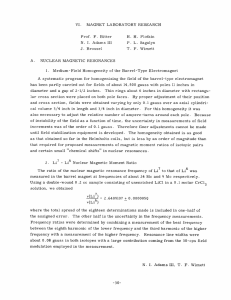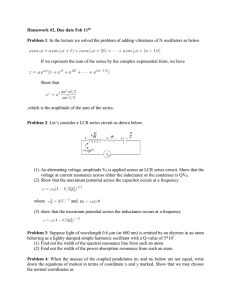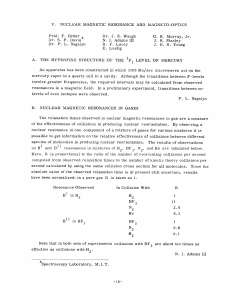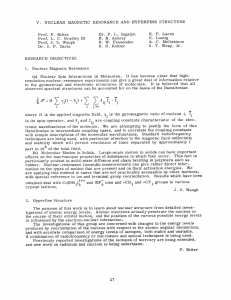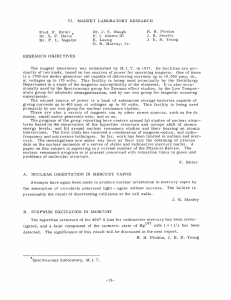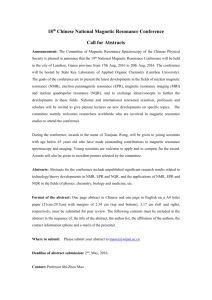VI. NUCLEAR MAGNETIC RESONANCE AND HYPERFINE ... Prof. F. Bitter
advertisement
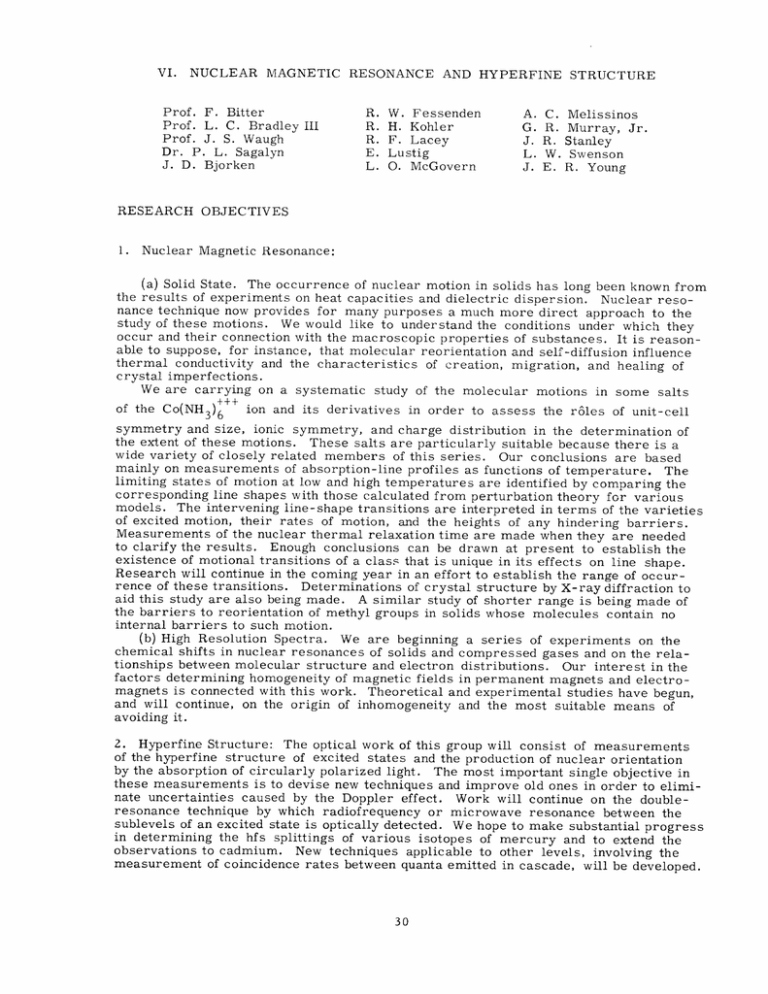
VI. NUCLEAR MAGNETIC RESONANCE Prof. Prof. Prof. Dr. P. J. D. F. Bitter L. C. Bradley III J. S. Waugh L. Sagalyn Bjorken R. R. R. E. L. AND HYPERFINE STRUCTURE W. Fessenden H. Kohler F. Lacey Lustig O. McGovern A. G. J. L. J. C. R. R. W. E. Melissinos Murray, Jr. Stanley Swenson R. Young RESEARCH OBJECTIVES 1. Nuclear Magnetic Resonance: (a) Solid State. The occurrence of nuclear motion in solids has long been known from the results of experiments on heat capacities and dielectric dispersion. Nuclear resonance technique now provides for many purposes a much more direct approach to the study of these motions. We would like to understand the conditions under which they occur and their connection with the macroscopic properties of substances. It is reasonable to suppose, for instance, that molecular reorientation and self-diffusion influence thermal conductivity and the characteristics of creation, migration, and healing of crystal imperfections. We are carrying on a systematic study of the molecular motions in some salts +++ of the Co(NH 3 ) 6 ion and its derivatives in order to assess the roles of unit-cell symmetry and size, ionic symmetry, and charge distribution in the determination of the extent of these motions. These salts are particularly suitable because there is a wide variety of closely related members of this series. Our conclusions are based mainly on measurements of absorption-line profiles as functions of temperature. The limiting states of motion at low and high temperatures are identified by comparing the corresponding line shapes with those calculated from perturbation theory for various models. The intervening line-shape transitions are interpreted in terms of the varieties of excited motion, their rates of motion, and the heights of any hindering barriers. Measurements of the nuclear thermal relaxation time are made when they are needed to clarify the results. Enough conclusions can be drawn at present to establish the existence of motional transitions of a class that is unique in its effects on line shape. Research will continue in the coming year in an effort to establish the range of occurrence of these transitions. Determinations of crystal structure by X-ray diffraction to aid this study are also being made. A similar study of shorter range is being made of the barriers to reorientation of methyl groups in solids whose molecules contain no internal barriers to such motion. (b) High Resolution Spectra. We are beginning a series of experiments on the chemical shifts in nuclear resonances of solids and compressed gases and on the relationships between molecular structure and electron distributions. Our interest in the factors determining homogeneity of magnetic fields in permanent magnets and electromagnets is connected with this work. Theoretical and experimental studies have begun, and will continue, on the origin of inhomogeneity and the most suitable means of avoiding it. 2. Hyperfine Structure: The optical work of this group will consist of measurements of the hyperfine structure of excited states and the production of nuclear orientation by the absorption of circularly polarized light. The most important single objective in these measurements is to devise new techniques and improve old ones in order to eliminate uncertainties caused by the Doppler effect. Work will continue on the doubleresonance technique by which radiofrequency or microwave resonance between the sublevels of an excited state is optically detected. We hope to make substantial progress in determining the hfs splittings of various isotopes of mercury and to extend the observations to cadmium. New techniques applicable to other levels, involving the measurement of coincidence rates between quanta emitted in cascade, will be developed. (VI. NUCLEAR MAGNETIC RESONANCE) Another project is concerned with the production of a useful "jet lamp" in which the Doppler width is reduced. Magnetic scanning techniques, previously reported, are to be further developed. Experience gained in avoiding the isotopic contamination of radioactive samples is to be put to use. As for nuclear orientation: the negative results have continued and they are discouraging. We propose, however, to carry on this work and hope, at least, to learn the reasons for the difficulties encountered. F. A. Bitter HIGH-SPEED POLE-FACE SCANNER A turbine-driven aluminum disk is mounted on a shaft and rotated at speeds of 10, 000 rpm or higher with the disk face close to the pole face of a magnet. coil, 0. 030 inch ID, A small 0. 080 inch OD, and 0. 045 inch thick, containing 900 turns of No. 50 wire, with a resistance of 150 ohms, is mounted on the aluminum disk one inch from the center of the disk with its axis parallel to the axis of rotation. few thousandths of an inch from the pole surface. It is The coil is within a connected by brushes to an amplifier and oscilloscope and shows the field inhomogeneities resulting from the inhomogeneity of magnetization of the iron. In the first observations that were made, effects were seen that were probably caused by the gradual change of radial magnetization; and small-scale variations, sup- posedly the result of domain and crystal structure, were observed. F. B. Bitter HOMOGENEOUS FIELDS PRODUCED BY DISTRIBUTIONS OF POLES For nuclear resonance studies, a permanent magnet with high homogeneity in a small region of space is being investigated theoretically. of an array of magnetized rods arranged in The magnet consists a circle about the direction of the field in such a way that the separation between the north and south poles may be varied (Fig. VIII-1). Calculations based on this model, assuming a uniform surface-pole distribution, were carried out. As usual, the B-field may be derived from a scalar potential V that m is a superposition of spherical harmonics with coefficients alm Since there is rotational symmetry of the form V( ) = V(4 + 450), the only nonvanishing am is I < 8. - 1form, a0 if In order to make the field near the origin unithe pole-geometry parameters are varied in such a way that the lowest a, vanish. The optimum values for pole parameters have been calculated for the array Fig. VI-1. Magnet model. of rods described above, and also for the array with an (VI. NUCLEAR MAGNETIC RESONANCE) additional rod in the center. In the latter case, all a, with 1< 7 (except I = 1) can be cancelled. Effects of slight asymmetry in the geometry and inhomogeneity caused by domain structure in the magnets are also being investigated. J. C. NUCLEAR MAGNETIC 1. Molecular Motion in Cobalt Compounds D. Bjorken RESONANCE IN SOLIDS Line-shape and relaxation-time measurements have been completed in seven salts of the hexamminecobaltic, Co(NH 3 ) + + , ion. Five of these show extremely broad linewidth transitions between liquid nitrogen temperature and 100°C. These transitions are qualitatively incompatible with a simple thermal-activation mechanism involving a single correlation time. The two mechanisms under consideration are as follows: 1. Each ion can reach one or a few torsional states and several free rotational states in the lattice potential. The average time of occupancy of a state is long because of weak coupling between the ions, so that the resonance absorption is effectively a superposition of that characteristic of each of the states. 2. Each ion can reach a number of torsional states, the highest of which have very large amplitudes. The average lifetime of a state is short, so that an ion behaves as if it vibrated with a certain average amplitude. The line-shapes are qualitatively in accord with both of these interpretations but they can be consistent with only one quantitatively and in detail. While the necessary calculations are not complete, the results are favorable to the first alternative at this time. If this should be the case, the measurements will give an approximate value for the average spacing of the rotational states and a value for the N-H distance in these complexes. 2. Molecular Motion in Hydrocarbons Several samples are ready for a trifluoromethyl groups in solids. study of the barriers to rotation of methyl and These compounds show long relaxation times. They could not be studied in detail until modifications in the apparatus (which are now complete) had been made. Calculations were made on the results of Thomas, Alpert, and Torrey (1) Tomita (2) relating to the states of motion in solid methane. and of We find that the experi- ments can best be interpreted by assuming the existence of barrier penetration in the rotation of molecules at all temperatures and self-diffusion at temperatures near the melting point, the latter having an activation energy of about 1. 5 kcal/mole. J. S. Waugh (VI. NUCLEAR MAGNETIC RESONANCE) References Alpert, and H. C. 1. J. T. Thomas, N. L. 1511L, 1950. 2. K. Tomita, Phys. Rev. 89, D. ISOTOPE SHIFT OF MERCURY 197-197 429, Torrey, J. Chem. Phys. 18, 1953. An ultraviolet absorption spectroscope was built for studying the position and magnitude of the resonance absorption lines of mercury. Several unusual features will be of The wavelength -1 A. 2537 at the ultraviolet light from the source is variable with a range of about 1 cm-1 noticed in the diagram of this device, which is shown in Fig. VI-2. This variation is accomplished by placing an electrodeless discharge lamp containing Hg198 in a variable magnetic field and observing parallel to the field. The resulting a-_ and a-+ components separated in wavelength by 2ygH are separated in space by means of a quarter-wave plate and a recently acquired Wollaston prism. The two beams, slightly divergent on emerging from the Wollaston prism, are sampled by the monitor photomultiplier B, then they traverse the Hg 197 finally fall on two separate signal photomultipliers, A and C. in the form of vapor and The three photomulti- pliers are fed from the same power supply and are arranged so that they have about the same incident flux; therefore the current collected at the final anode is an accurate measure of the incident flux. DC )GE Fig. VI-2. Diagram of the apparatus. (VI. NUCLEAR MAGNETIC RESONANCE) These photocurrents are compared on a dc bridge that measures iA/iB or iC/i B These ratios correspond to I Intensity of u/v transmitted through cell I Intensity of u/v incident on cell The apparatus scans a line of pure Doppler shape across a Doppler-broadened absorption trough. If the small natural linewidth is neglected, and the center of the incident line coincides with the center of the absorption trough, then I (P/Tr)1/2 1/2 Z 0 - exp (-k N)n n=0 n (n+p) -k N e-k - 2 1/2 where ko is the photon-capture cross section, N is the number of atoms in the beam, and 1/2 1/2 is the ratio of the Doppler widths of the incident light and the absorption trough; usually P 1. state; and by k 0 The quantity ko can be calculated for the lifetime of the upper atomic using the value found in this laboratory by Bitter and Brossel, - 13 = 4. 65 x 10 is obtained. Tables of the integral given above are in preparation. can be made for the isotope Hg I 0. 16 I 202 of natural mercury; An approximate calculation it yields 0. 05 0 Measurements with a cell containing natural mercury give for Hg 2 - I 02 0. 20 + 0. 02 J. E. THE HYPERFINE STRUCTURE BY DOUBLE-RESONANCE OF THE 3P 1 E. R. Young STATE OF MERCURY METHODS The apparatus for studying various microwave transitions in the 3 P state of mercury was rebuilt in order to increase the amount of light incident on the resonance cell. The usual double-resonance method (1) is used. The arc, containing pure Hg 9 8 is in a magnetic field. Varying the magnetic field on the arc (2) varies the wavelength of the incident light, permitting the selective excitation of various levels and isotopes. The magnetic field on the resonance lamp can be varied independently to obtain the (VI. NUCLEAR MAGNETIC RESONANCE) correct splitting for the radiofrequency used. Measurements at 3100 Mc/sec are in progress on: 1. the gj factors of the even isotopes, measured separately; 2. the isotope shifts of the even isotopes, measured by plotting the amplitude of the radiofrequency resonance versus the magnetic field on the are. (This method eliminates the effects of overlapping optical lines from the odd isotopes.) 201 199 and Hg 3. the hyperfine structure of Hg Equipment is being assembled for measurements at 7. 5-11 Mc/sec. It is planned to extend the measurements to the radioactive isotopes. P. L. Sagalyn, R. H. Kohler References 1. J. Brossel and F. 2. F. Bitter, S. P. Bitter, Phys. Rev. 86, and J. Davis, B. Richter, 308 (1952). E. R. Young, Phys. Rev. 96, 1531 (1954). F. LIFETIME OF THE 3P 1 STATE OF CADMIUM The radiofrequency resonance in the 3 P1 Zeeman levels of the even isotopes of cadmium has been observed by using the double--resonance method previously reported (1). These measurements at low radiofrequency amplitudes are expected to yield a new value for the mean lifetime of this metastable state. R. F. Lacey References 1. J. Brossel and F. Bitter, Technical Report 176, Research Laboratory of Electronics, M.I.T., Sept. 12, 1950. G. NONRADIATIVE TRANSFER OF ENERGY BETWEEN ATOMS IN A VAPOR A problem of interest in experiments with the resonance radiation of vapors is the mechanism for the depolarization of the radiation and for the nonradiative transfer of excitation from one atom in the vapor to another. One way in which this can take place is by the electric-dipole (Van der Waals) interaction between an excited and an unexcited atom (1). It has been shown that after one of two identical atoms has been excited to a given magnetic substate, the excitation will have passed to other substates of the twoatom system after a time - TR3 (2) and T 4 X- 3, where R is the distance between the atoms is the lifetime of the excited state. R. F. Lacey (VI. NUCLEAR MAGNETIC RESONANCE) References 1. D. Bohm, Quantum Theory (Prentice-Hall, Inc., H. INTENSITY MEASUREMENTS OF RESONANCE RADIATION FROM MERCURY ARCS New York, 1951), p. 472. Several sources of mercury (natural and 198) resonance radiation are used by this To further our knowledge of their relative intensities a simple apparatus was devised, and some measurements taken. The results are given below. group. The different sources are compared by means of the output of a photomultiplier tube. Since the response of this device, over a wide range, is far from linear, the apparatus is so designed that by varying other parameters the tube output can be kept of the same order of magnitude for all sources. 1. Description of the Apparatus The apparatus consists of a lower part in which the different apertures can be suitably mounted and regulated. Light is admitted through interchangeable apertures to the upper part, in which the photomultiplier is mounted on a sliding rack so that its distance from the aperture can be adjusted at will. The photomultiplier is shielded, and the part of its cathode surface exposed to the incident radiation can be regulated by means of another interchangeable aperture. Moreover, it was found advisable not to vary the exposed surface, and so a standard circular aperture with an area of 33. 6 mm2 is used. The apertures used at the lower part, with areas from 5. 5 x 10 - 3 mm2 to 4.46 mm2 were so designed that each aperture is as close as possible to the emitting surface. The solid angle through which the upper aperture is seen defines the radiation flux incident on the tube and, combined with the area of the lower aperture, gives the radiation per unit area of emitting surface. To isolate the resonance radiation, several different filters are used between the photomultiplier and the source. All measurements are taken with (a) a Corning No. 9863 ultraviolet-transmitting filter, used to eliminate as much of the visible spectrum as possible; and (b) a Corning No. 9700 (pyrex) ultraviolet-blocking filter inserted in the path of the radiation. Thus, the difference between a signal passed by (a) and a signal passed by the combination of (a) and (b) is believed to be mostly 2537 A radiation. The characteristics of these two filters are: (a) the Corning No. 9863 ultraviolet-transmitting filter, at 2537 A, passes 50 per cent; between 3000 A and 3800 A, it passes 80 per cent. NUCLEAR MAGNETIC RESONANCE) (VI. (b) the Corning No. 9700 ultraviolet-blocking filter, at 2537 A, passes zero; over 3000 A, it passes 80 per cent. A quartz cell containing mercury vapor is used to absorb the 2537 A radiation selectively, but even without mercury the signal, when passing through the two quartz walls of the cell, is attenuated 18 per cent. The detecting device is an RCA 1P28 photomultiplier tube (u/v-sensitive) operated at 980 volts and at a mean value of 15 sible to this current flow. a, so that all data are taken as close as pos- The tube has a 70 per cent response to 2537 A, but it is also sensitive to a part of the visible spectrum. 2. Experimental Results The intensities given are in photocurrent per cm2 of emitting surface per unit solid angle. This photocurrent, converted by the calibrating factor 22,000 jpa/ Lw, is given in the second column of Table VI-1 as the total rate of radiated energy in milliwatts per cm2 per steradian. It must be noted that since the calibration might vary as much as 40 per cent from tube to tube, the absolute value of the measurements will be affected accordingly, and, moreover, the signal is already attenuated by approxi- mately 50 per cent while passing through a No. 9863 filter. Table VI-1 Summary of Relative Intensities at 2537 A of Mercury Arcs amp/cm 2 - steradian Arc watts x 10 cm 2 3 - steradian 2537 A Radiation (per cent) Hot Cathode High current (3 amp) Mineralight 258 69 11.4 3. 05 90 88 Electrodeless Discharge F-shaped natural Hg arc 680 30. 0 52 198 arc No. 3 675 29. 8 32 Pure natural Hg arc 340 15.0 52 198 arc No. 1 334 14.8 55 220 9.75 40 198 arc No. 2 162 7. 16 29 198 arc No. 9 51 2. 26 35 0. 96 76 Natural Hg arc No. 11 Cold Cathode HV discharge tube 22 *Except for this arc, all are filled with argon at 2-3 mm Hg. (VI. NUCLEAR MAGNETIC RESONANCE) The last column in Table VI-1 gives the percentage of 2537 A radiation of the total radiation intercepted by the photomultiplier. Several kinds of sources were investigated under widely differing operating conditions. A summary of the intensity maxima obtained is given in Table VI-1. The intensity of the discharges was very sensitive to external cooling. It was also observed that there is an optimum mercury vapor pressure with a rather sharp peak not wider than 10 0 C. The apparent changes in intensity in the microwave arcs that accompany changes in magnetron current are caused by temperature effects attributable to increased power dissipation in the waveguide and the cell. 3. Comparison of Measurements with Theoretical Estimates An attempt will be made to show that the data obtained by these intensity measurements are of the same order of magnitude as those predicted by theory. For the hot-cathode discharge tube, the formulas given by J. F. Waymouth and F. Bitter are used. Unfortunately, it was not possible to record the exact value of the wall temperature in the measurements and, hence, the vapor pressure (pHg). Thus, apart from the dimensions of the tube and the argon pressure the only known quantities are the axial field and the current. By trying different values for pHg it is found that the total losses per electron (1) are nearly constant, while the maximum loss to excitation is obtained with a PHg of 10-20 microns, corresponding to a bulb-wall temperature of approximately 50'C. This agrees with the estimated optimum temperature. With pHg = 20 microns, we obtain (see ref. 1) Hg3 T' e = 3 X 10 parameter where T' = 1. 33 (1) = 1. 95 x 10 T eff , - 3 (2) T eff being the average lifetime of a photon in the mercury vapor before escape; and ne is the mean electron density per m3 From values 1 and 2, we obtain Te = 14. 600 0 K (3) which gives Wei weg = = = 2.45 x 10 eur= 2. 6 X 10 we, = 2.6 Wet = - 14 x 2 = X 20 = 10- 13x 20 = = 3. 73 X 10 0.49 5. 2 10 10 - 13 - 13 -13 watt/electron watt/electron watt/electron 5. 2 x 10-13 watt/electron 14. 6 x 10 - 13 watt/electron (VI. NUCLEAR MAGNETIC RESONANCE) is the is the loss to elastic scattering; w where w . is the loss to ionization; w eur 3 eg el loss to excitation to higher levels; w e is the loss to excitation to 6 P levels; and wet is the total loss per electron. Hence E = 151 volts per meter which is in perfect agreement with our starting value of nY for a current of 0. 5 amp. e If we consider the loss to excitation (We*) in watts/electron we shall have for the rate of energy radiated per unit solid angle per cm : n~x0-2 we* ne Ax 10 w = Lw where A is the cross section of the tube, and L is the circumference in centimeters. For a diameter of 6 mm, we obtain w = 45. 8 x 10 - 3 watts/cm2 - steradian which is of the same order of magnitude as the values of the measured intensities. For the microwave arcs, the intensity is calculated by considering black-body radiation and assuming a width of 1500 Mc/sec for the 2537 A line. Then q = 8w ch X- V = 8w h X where %and -3 5 exp (-ch/XkT) and, using the conversion factor X /c, exp (-hv/kT) v denote, as usual, the energy per unit volume per wavelength and per cycle, respectively. For T = 10.2 X 10 x12e - v = 14, 200 0 K and X = 2537, = 18.9 X 10 - 4 erg/sec - cm - cps Then the rate of radiated energy per unit area i 1=L c 6 22 - 1. 33 X 10 = 133 X 10 - 3 3 erg/sec - cm watts/cm 2 - steradian which is again of the order of magnitude of the observed value for reasonable estimates of T . e A. C. Melissinos References 1. J. F. Waymouth and F. Bitter, An analysis of the plasma of fluorescent lamps (to be published in the Journal of Applied Physics). (VI. I. NUCLEAR MAGNETIC RESONANCE) DOUBLE-RESONANCE CALCULATIONS Calculations were made for the purpose of describing the behavior of atomic systems subjected simultaneously to electromagnetic waves of two frequencies: radio or microwave, and optical. The system considered is an atom interacting with a radiofrequency wave, both of which are enclosed in a resonant cavity. The field in the cavity is expressed in terms of the normal modes of the cavity and then quantized in a manner exactly analogous to that commonly used for optical waves. If we consider that the radiofrequency field causes transitions between states of the atom, we treat the interaction between field and atom as a perturbation, and use timeindependent perturbation theory to construct wavefunctions that form an approximately diagonal Hamiltonian. For example, if the atom has two states, a and b, with energy separation Wab , and if the radiofrequency w is nearly equal to wab, then the zero-order state which has the atom in state a, and n radiofrequency photons present, is nearly degenerate with the state which has the atom in state b and (n-l) radiofrequency photons present. To take account of the perturbation (assumed to have nonzero matrix elements between these states) we form linear combinations of these two wavefunctions which make the Hamiltonian diagonal. There is an infinite number of such pairs of states corresponding to the infinite number of values of n. If w = wab' the two states that were exactly degenerate in the zero-order state are separated in energy by an amount proportional to the amplitude of the radiofrequency field. These results are exactly the same as those obtained by Pryce (1) using Rabi's time-dependent wavefunctions where the radiofrequency field is strong enough so that there are several radiofrequency photons per mode - the condition for a classical field. J. R. Stanley References 1. M. H. L. Pryce, Phys. Rev. 77, 136 (1950). J. COINCIDENCE TECHNIQUES 1. Radiofrequency Method A new method has been devised for the study of the hyperfine structure of excited states of atoms. This method may be used because it has become possible to observe coincidences between optical quanta emitted in cascade (1), so that it is known that the two observed quanta have been emitted by the same atom, barring accidental coincidences. It is best explained by describing a simple case. (VI. M:1 NUCLEAR MAGNETIC RESONANCE) Consider an atom with three energy levels, each having J = 1/2, and magnetic sublevels M = +1/2. 2 Sx, The atom undergoes transitions from the first level to the second, emitting wavelength =2 Fig. VI-3. Level diagram. and from the Xl, second to the third, emitting wavelength X . The emitted light is sent through a spectrograph, and a photomultiplier counts each of these wavelengths. If a quarter-wave plate and a polaroid are placed before each photomultiplier, they will count only one circular polarization, corresponding, let us say, to A~m = -I in each case. Fig. VI-3 will show that no atom (in this simple case) can emit a pair of such photons in succession. Therefore, only accidental coincidences between the two counters will be observed. If, however, the atom is subjected to a radiofrequency field of the correct frequency to induce transitions between the magnetic sublevels of the intermediate state, coincidences will be observed. true Thus, a rise in the coincidence rate will be a means of detecting the resonant frequencies of the intermediate state. The situation is somewhat more complicated when hyperfine structure is present, but the same principles apply. The relationship between the polarizations of the two photons will be the same as that found by double-resonance techniques which this group has used for several years. From the point of view of the quantum theory of radiation, these are two-quantum processes, characterized by the same types of matrix elements. The new method is expected to be particularly useful in examining the hyperfine structure of the wide class of excited levels not accessible to double-resonance or similar techniques (for example, the atomic-beam technique of I. I. Rabi). At the present time, work is proceeding toward finding a suitable light source and is continuing on the counting electronics. The element chosen for study is barium, principally because its spectrum contains a pair of wavelengths in the most convenient range. information to be gained (for instance, and, The the quadripole moments of the odd isotopes, by the use of P. L. Sagalyn's technique (discussed below), the isotope shifts) is of considerable interest, since these isotopes are near the neutron magic number 82. L. C. Bradley III References 1. E. Brannen, F. R. Hunt, R. H. Adlington, and R. W. Nicholls, Nature 175, 810L (1955). 2. Optical Method As L. C. Bradley pointed out above, the coincidence for radiofrequency measurements on higher atomic states. technique can be used It can also be used to increase the accuracy of optical wavelength measurements to a great extent, without (VI. NUCLEAR MAGNETIC RESONANCE) using radiofrequency techniques. The linear momentum of the first photon is negligible with respect to that of the emitting atom, and the arc can be run so that the probability of collision during the lifetime of the intermediate state is negligible. Doppler shifts of the two photons are correlated. For example, Therefore the if the two photons are emitted in the same direction, their Doppler shifts will be the same. If we let the energy level scheme be that given in Fig. VI-4, XI is the wavelength of the first photon and X2 is the wavelength of the second photon. Let us assume that the three levels are single so that only two lines appear in the spectrum. A suggested arrangement of the apparatus is through spectrograph and it is shown in Fig. VI-5. Light dispersed into two lines in the focal passes the plane of the instrument. z X, Fig. VI-4. I2 X2 +A- S, Level diagram. S 18O 1800 0° 0 ANGLE BETWEEN Fig. VI-5. X , COINCIDENCE RATE VERSUS POSITION OF S2 X2 Apparatus schematic. The resolving power of the instrument is assumed to be high compared with the Doppler width and is represented schematically by the two slits, S 1 and S 2 with z component of velocity, later, X2 . vz, is . A particular shown emitting first X1 and then, a short time The Doppler shift for each photon will be proportional to vz/c might call the "phase" of the Doppler shift. atom , which we With the apparatus arranged as shown, both X1 and X 2 will have the same phase and will appear at the same place in their respective Doppler distribution curves. Let us suppose that slit S l is located so that it will pick up X . Now imagine slit S 2 I to move across line 2. True coincidences will occur only when S2 is at the same phase as Sl . The width of the response will depend only on the slit width and natural width and not on the Doppler width. To find the position of the Doppler curve maximum we imagine that the apparatus is arranged so that we look at the second photon in a direction just (VI. opposite to that used in the first measurement. NUCLEAR MAGNETIC RESONANCE) The response will then occur at the symmetrically opposite position on the Doppler curve. The mean of the two wavelength readings will then give the position of the center. If the lines have structure - for example, if the bottom level is a doublet giving two possible second photons with wavelengths X2 and X 2 + akX- then the resolving power will also be determined by slit width and not by Doppler width. The optical method will probably be most useful when the radiofrequency method does not apply; for example, in the measurement of the "isotope shift" of spectral lines. The increased accuracy of optical wavelength measurement may make it possible to look for isotopic effects in other parameters, such as the fine structure of the levels of heavy elements. P. L. Sagalyn


